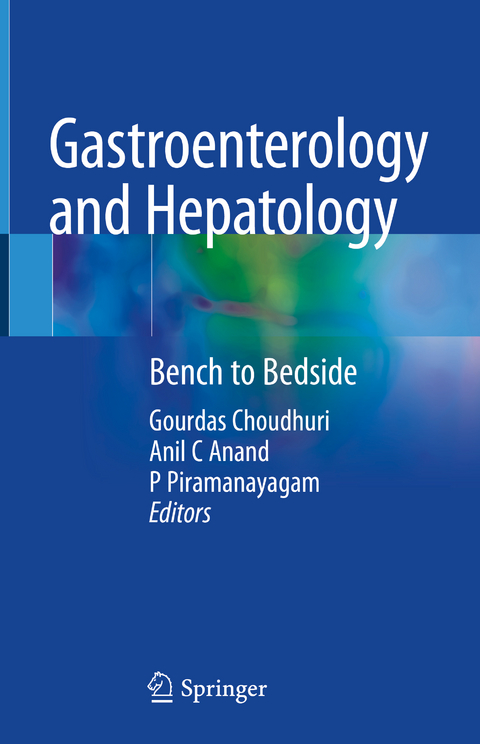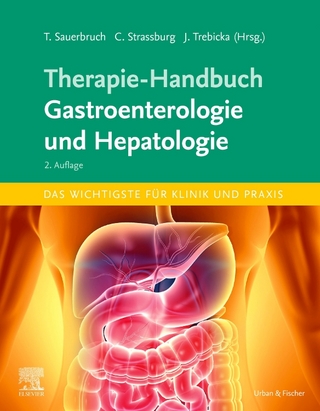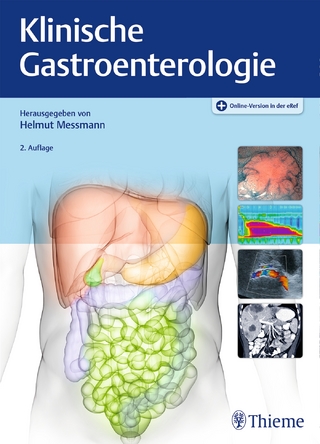
Gastroenterology and Hepatology
Springer Verlag, Singapore
978-981-99-9286-7 (ISBN)
Dr.Gourdas Choudhuri, MD (Medicine), DM(Gastroenterology), FACG, FAMS, FICP, FRCP, Chairman and Head, Department of Gastroenterology and Hepato-biliary Sciences, Fortis Memorial Research Institute, Gurgaon, Haryana, India Dr. A. C. Anand MD (Medicine), DM (Gastroenterology), FICP, FSGEI, FRCP(London), FRCP (Edinburg), FACP, FACG, FAMS, Professor and Head, Department of Gastroenterology & Hepatology Kalinga Institute of Medical Sciences, Bhubaneshwar, India Dr Piramanayagam P, MD (Medicine), DM Gastroenterolgy), Consultant, Department of Gastroenterology, Apollo Hospitals 21, Greams Lane, Off Greams Road Chennai, India
Section 1. Esophagus
A. Anatomy /Histology/Embryology1. Lower Esophageal Sphincter 2. Barret’s esophagus3. Webs, rings, diverticulae in esophagus4. Cross sectional anatomy of esophagus: Tumor staging5. Esophagus in portal hypertension 6. Tracheosophageal fistula B. Physiology 7. Acid clearance mechanism and defects in GERD 8. TLESR 9. Neurophysiological basis of esophageal peristalsis [normal manometry values C. Genetics 10. Genetic polymorphisms in GERD 11.Biomarkers in Barret’s esophagus D. Pathology 12. Pathogenesis of achalasia cardia 13. Eosinophilic esophagitis: histopathology difference from reflux esophagitis E. Pharmacology 14. Drugs acting on the LES
Section 2. Stomach
A. Anatomy and physiology1. Cross sectional anatomy of stomach2. Innervationof stomach- Types of vagotomy3. Post GJ/gastrectomy anatomy4. Parietal cell and the proton pump5. Chief cell6. Enterochromaffin cells in stomach7. Fundic gland: histology8. Pyloric glands: histology9. Gastric pacemaker10. Blood supply –Arterial, venous supply of stomach and GE junction11. Lymphatic drainage of stomach12. Gastric volvulus13. Intestinal metaplasia and atrophic gastritis14. Gastric bed/ Lesser sac/Foramen of WinslowB. Physiology 15. Gastric mucosal defense and its breakdown in peptic ulcer 16. Gastric proton pump 17. Neurohormonal control of gastric acid secretion 18. Gastric motility- Difference in fundus and body motility 19. Leptin 20. Motilin 21. Physiological basis of breath tests for H.PyloriC. Genetics 22. H.Pylori virulence factors-cag, vac genes 23.Host genetic polymorphisms and outcome of H.Pylori infection 24. Host genetic polymorphisms and response to PPI 25. c-kit mutation and response to therapy in GIST D.Pathology 26. Molecular pathogenesis of gastric cancer [Corea’s hypothesis] 27.Pathogenesis of H.pylori associated gastric lymphoma 28. NSAID associated gastric mucosal injury 29. Autoimmune gastritis 30. Granolomatosis gastritis E. Microbiology 31. H.Pylori- structure, stains for H.pylori F. Pharmacology 32. PPI/ H2 blockers 33. Dopamine antagonists 34. Serotonin antagonists
Section 3. Small intestine
A. Anatomy/ Histology/Embryology1. Development of small intestine and malrotation2. Meckel’s diverticulum3. Neural plexuses: Meissner’s/Aeurbach’s plexus4. Villous anatomy5. Microvilli6. Intraepithelial lymphocyte7. Brunner’s gland 8. M cells9. Paneth cells10. Zona occludens11. Toll like receptors12. Intestinal stem cells B.Physiology 13. MMC 14.Intestinal Pacemaker 15.Intestinal Permeability 16.Small Bowel Permeability (SIP) 17. Mucosal Defence 18. Immunoglobulin A 19. Defensins 20. Enterokinase 21. Cholecystokinin 22. Secretin23.Incretins24. Peptide YY- ileal brake25. Brain gut axis C.Biochemistry 26. Carbohydrate digestion 27. Protein digestion 28. Lipid digestion 29. Vitamin B 12 absorption 30.Iron absorption and metabolism 31. Copper absorption 32. Vitamin D metabolism 33.Bile acid transport: Enterohepatic pathway 34. Cholestrol metabolism 35.D-Xylose test 36. Vande Krammer test 37. Breath tests for malabsorption-physiological basis 38. Breath tests for SIBO-physiological basis 39. Intestinal adaptation D. Pathogenesis 40. Protein losing enteropathy 41.Eosinophilic gastroenteritis 42.Celiac sprue 43. Tropical sprue 44. Intestinal tuberculosis 45. SIBO 46.Short gut syndrome 47. Radiation enteritis 48.Indeterminate colitis 49. Pathogenesis of IBD E. Microbiology50. Normal gut microbiota51. Lifecycle of parasites52. Bacterial toxins causing diarrhea53. Opportunistic pathogens in HIV patients54.ASCA and ANCA: Role in IBD F. Pharmacology55.Probiotics56. ORS-New Vs old; super ORS57.Zinc and its role in small intestinal diseases58. Green banana diet59. Vaccines for intestinal infection60. Enteral nutrition-types and indications61. Immunonutrition62. 10.5-ASA preparation and small intestinal release63. TPMT assay and azathioprine metabolism64. Biologicals in I BD65. Methotrexate and folic acid G. Genetics 66. CARD/ NOD genes 67. Genetics in IBD/IBD genes -Indian scenario 68. Lactase genes
Section 4. Large intestine
A. Anatomy/ Histology/Embryology1. Anal sphincters 2. Dentate line 3. Rectal folds (Valves of Houston) 4. SRUS-Histopathology 5. Adenomatous polyps- Types and significance 6. Juvenile and hamartomatous polyps B. Physiology7. RAIR 8. Fluid handling by intestine 9. Colonic motility10. Defecation-mechanism11. Intestinal fistulas C. Biochemistry12. Short chain fatty acids13. Fecal occult blood test- Types, limitations D. Pathogenesis14. Ulcerative colitis15. Pseudomembranous colitis16. Molecular pathogenesis of colonic cancer17. Amebiasis18. Microscopic colitis 19. Newer concepts in pathogenesis of IBS20. Montreal classification of IBD21. Pathogenesis of pseudo-obstruction
Section 5 . Liver
A. Anatomy/Histology/ Embryology1. Hepatocyte2. Cholangiocyte3. Ito cell4. Stellate cell5. Hepatic stem cell6. Kupffer cells7. Hepatitis B- structure and replication8. Hepatitis C –structure and replication9. Hepatitis E- structure10. Hepatic sinusoid11. Venous drainage of liver- importance in Budd Chiari syndrome12. Ligaments of liver, surface anatomy of liver13. Segments of liver 14 .HBV mutants15. IL-28B polymorphism and HCV B.Physiology 16. Bilirubin metabolism and congenital disorders 17. Bile salt metabolism-enterohepatic shunts, congenital disorders 18. Liver as an immunological organ 19. Ammonia handling in liver, kidney, brain, muscles 20. Ethanol metabolism 21. Aminoacids- Branched chain : relevance in liver disease 22. Urea cycle and congenital defects 23. Eneterohepatic Circulation C. Pathology 24. Necroinflammatory and fibrosis scores 25. Pathogenesis of alcoholic liver disease 26. NAFLD-Pathogenesis 27. Wilson’s disease 28. Hemochromatosis 29. Glycogen storage disorders 30. HCC-molecular pathway 31. Hepatic fibrosis- pro and antifibrotic mechanisms 32. Hepatic encephalopathy- pathogenesis 33. HRS- pathophysiology 34. Ascites in liver disease – pathogenic mechanism 35. NCPF: pathogenesis 36. EHPVO: pathogenic mechanisms 37. Pathogenesis of portal hypertension in cirrhosis – role of structural and functional reasons for portal hypertension 38. Pathogenesis of hepato-pulmonary syndrome 39. Pathogenesis of ALF 40. Endocrine complications in cirrhosis D. Microbiology 41. Genotyping methods 42. ELISA 43. HBV life cycle 44. HCV replicon 45. Malarial, enteric, dengue hepatopathy 46. Mechanisms of HBV and HCV related HCC 47.HCV and steatosis E. Pharmacology 48. Interferons 49 Ribavirin 50. Eltrombopag 51. Sorafenib 52. Nucleoside analogues/nucleotide in HBV therapy 53. L-Ornithine L- Aspartate 54. Lactulose and other ammonia lowering agents 55. Somatostatin analogues 56. Role of viral kinetics in HCV treatment 57. Role of HBsAg titre in HBV treatment 58. Side effects of oral antiviral therapy and its pathogenesis
Section 6. Bile duct, Gall bladder and Pancreas
A. Anatomy/ histology/ embryology1. Pancreas development- Pancreas divisum, Annular pancreas, Ducts of Morgagani, Santorini2. Choledochal cyst- Todani classification, types3. Lesser sac anatomy-pancreatic pseudocyst4. Sphincter of Oddi 5. Pancreatic stellate cells6. Pancreatic stem cells 7. Pancreas- endocrine functions- Pancreatic neuroendocrine tumors B. Physiology 8. Bile production- bile acid dependent and -independent mechanisms 9. Gallbladder bile Vs duodenal bile- changes incompositon 10. Neurohormonal control of pancreatic secretion 11. Neurohormonal control of biliary secretion 12. Normal pressures in pancreatic and bile ducts 13. Pancreatic enzymes- functions and feedback regulation C. Pathology 14. Microlithiasis 15. Gallstone formation- supersaturation, nucleation, gallbladder dysmotility 16. Gallstone- types and composition 17. Pathophysiology of alcoholic chronic pancreatitis 18. Pathophysiology of acute pancreatitis 19. Pancreatic malignancy-molecular mechanism 20. Cystic neoplasms of pancreas-Difference from pseudocyst 21. Autoimmune pancreatitis 22. Gallbladder carcinoma- etiopathogenesis 23. PSC 24. PBC 25. Pain in chronic pancreatitis- pathophysiology D. Pharmacology 26.Octreotide 27. Pancreatic enzyme supplements 28. Ursodeoxycholic acid 29. Statins
E. Genetics 31. Genes in chronic pancreatitis with relevant Indian data 32. Genetic polymorphisms in gallstone disease
Section 7. Miscellaneous
1. SiRNA 2. Genetics of celiac disease 3. Cannabanoid receptors 4. Cadherins 5 . Carcinoids in GI / Carcinoid syndrome 6. CMV disease in GI and Liver 7. Role of Integrins: development of biologics like natalizumab 8. Wnt: GI Stem cells B-catemin 9. Hedgehog: role in pancreas 10. EGFR/ receptor tyrosine kinases/ K Ras 11. IFN signalling: antiviral immunity 12. Overview of innate immunity 13. T cell subsets: Th1, Th2, Th17 14. B cells / Eosinophils 15. TGF B pathway 16. G Coupled protein receptors 17. Small GTPases : Rho/ Rac/ CDC 42 18. Angiogenesis 19. GWAS 20.Transcription factors 21. Oncogenes 22.Tumor suppressor genes 23.Telomerase 24. Liver nuclear receptors 25. Role of Vit D in GI diseases 26. Apoptosis 27. Gene therapy in Gastroenterology 28. Stem cells in Gastroenterology
| Erscheinungsdatum | 04.07.2024 |
|---|---|
| Zusatzinfo | 70 Illustrations, color; 1 Illustrations, black and white; XXXIX, 505 p. 71 illus., 70 illus. in color. |
| Verlagsort | Singapore |
| Sprache | englisch |
| Maße | 155 x 235 mm |
| Themenwelt | Medizin / Pharmazie ► Allgemeines / Lexika |
| Medizinische Fachgebiete ► Innere Medizin ► Gastroenterologie | |
| Medizinische Fachgebiete ► Innere Medizin ► Hepatologie | |
| Studium ► 1. Studienabschnitt (Vorklinik) ► Anatomie / Neuroanatomie | |
| Studium ► 2. Studienabschnitt (Klinik) ► Anamnese / Körperliche Untersuchung | |
| Studium ► 2. Studienabschnitt (Klinik) ► Humangenetik | |
| Schlagworte | basic sciences • Clinical implications of bench knowledge • Clinical Signs and Symptoms • gastroenterology • GERD • hepatology |
| ISBN-10 | 981-99-9286-9 / 9819992869 |
| ISBN-13 | 978-981-99-9286-7 / 9789819992867 |
| Zustand | Neuware |
| Haben Sie eine Frage zum Produkt? |
aus dem Bereich


